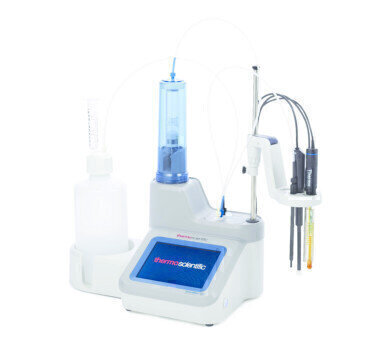-
 Thermo Scientific™ Orion™ Star All-in-One T940 Titrator
Thermo Scientific™ Orion™ Star All-in-One T940 Titrator
Laboratory Products
Choosing a Titrator for Your Lab
Sep 07 2018
Most scientists learn about volumetric analysis following a manual titration method, so it’s a natural solution when faced with the need to titrate. However, manual titrations are often problematic. They can be time-consuming and more critically, prone to human error, which can create a great deal of waste within the lab. Automating acid-base, redox, and ion titrations may help improve lab productivity and optimise accuracy and reproducibility of your results.
Automated titrators are designed to make performing titrations easier, more reliable and more reproducible than manual titrations. They work by expanding the number of ions and compounds that can be measured beyond direct electrode analysis and offer dynamic process controls that adjust the titration to optimise analysis results.
When looking for an automated titrator, it’s important to evaluate your needs based on the type of volumetric analysis needed, whether you plan on repeating titrations and how you plan on managing the data you gather.
Selecting a titrator by application
Choosing the perfect titrator is critical to optimising your processes. It’s important to first recognise whether you will be performing frequent titrations using a dedicated titrator to analyse a large number of similar samples or performing titrations on a small number of diverse samples.
Titrators can be found in a variety of formats, such as pH, redox or ion selective electrodes (ISE). If you plan to measure acidity or alkalinity a pH titrator may work best for you. If you are looking to measure dissolved oxygen in wastewater by Winkler titration or organic matter in soil, a redox titrator may be a better fit. Use of ISE may yield better results when measuring the total hardness of drinking water and wastewater or other chemicals such as chloride, ammonia or calcium. A combination of pH, redox and ISE may suit you better if you need a flexible model for a variety of measurements. More information on identifying the best titrator for your application can be found in the eBook Best Practices using Automated Titrators.
Recording methods and results
Accuracy in titration, is critical, and is one of the main benefits of choosing an automated titrator over a manual set-up. When selecting your titrator, look for one that clearly displays test data and also provides a way to store and recall data.
Features to consider when comparing automated titrators include: number of cycles per sample that the instrument runs, analysis of average concentration and relative standard deviation (RSD) values, and importantly flexibility within the system to exclude any outlier cycle runs. You may also benefit from finding a titrator that offers the flexibility of long-term data retention into sharable file formats such as PDF or comma-separated value (CSV) files.
Programmable titration
When performing similar titrations over a period of time, it is convenient to use a programmable instrument. Preset programs are a key method for avoiding human error in measurement. The Thermo Scientific™ Orion™ Star T900 Series Titrators are an example automated potentiometric titrators that allows you to set programs for repeat experiments, helping to ensure that you get consistent results and reduce waste from erroneous titrations. Just program it once and your Orion Star titrator will take care of the rest – including addition of titrant, endpoint determination, results calculation, and data logging.
Using the Titration Setup Wizard users are able to setup parameters for equivalence point or preset endpoint titration. These settings are saved and password protected for when a layer of security is needed. Copying methods and modifying them for similar samples that require minor parameter changes can be done easily. You can even share your methods among multiple titrators using a USB flash drive.
When thinking about your long-term titration needs, an automated titrator may help you streamline your experiments. Manual titration is time consuming, difficult to replicate and less reliable, and requires manual data capture – all of which can be a strain on your lab. If you’re doing manual titration, it’s time to switch gears.
Digital Edition
Lab Asia 31.2 April 2024
April 2024
In This Edition Chromatography Articles - Approaches to troubleshooting an SPE method for the analysis of oligonucleotides (pt i) - High-precision liquid flow processes demand full fluidic c...
View all digital editions
Events
May 21 2024 Lagos, Nigeria
May 22 2024 Basel, Switzerland
Scientific Laboratory Show & Conference 2024
May 22 2024 Nottingham, UK
May 23 2024 Beijing, China
May 28 2024 Tel Aviv, Israel








.jpg)








